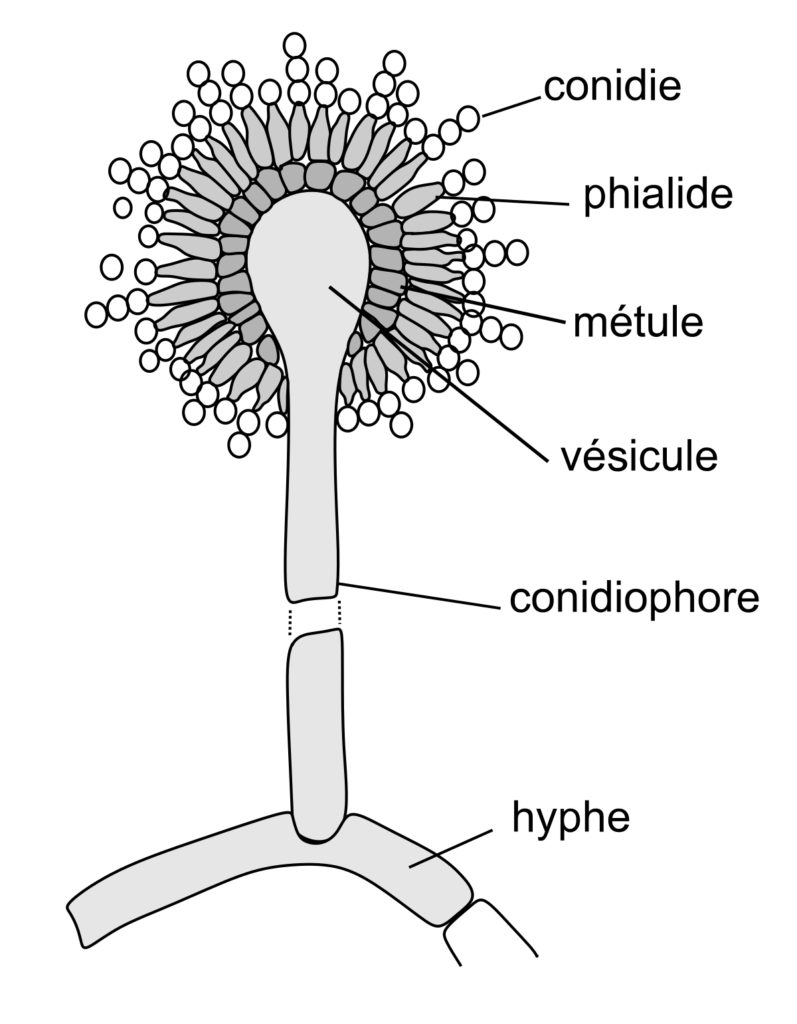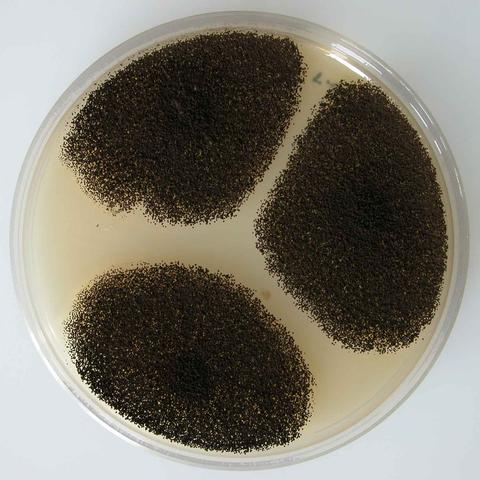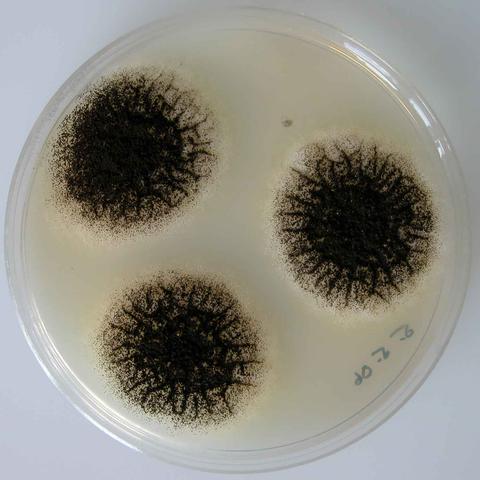Aspergillus niger is the most common species of aspergillus.
- Its name is adapted from the Latin name aspergillum, which means holy water sprinkler because it has a sprinkler like an appearance when viewed under a microscope.
- It is known commonly to cause black mold in fruits and vegetables like grapes, apricot, onions, and peanuts.
- It is also known to cause food contaminations or food spoilages.
- It also has mild opportunistic characteristics of causing opportunistic respiratory infections associated with pneumonia in immunocompromised individuals than the other species of Aspergillus such as Aspergillus flavus, Aspergillus fumigatus, and Aspergillus clavatus.
- It is found ubiquitously in soil and sometimes indoors, appearing black, hence the black mold.
- Beneficially, Aspergillus niger has been used for centuries in the production of citric acid that is a common food preservative in canned fruits, shampoos, and blood preservative.
- Some strains of Aspergillus niger produce mycotoxins, including ochratoxin A, isoflavone orobol inhibitor.
Read also: Aspergillus fumigatus
Interesting Science Videos
History of Aspergillus niger
- Aspergillus niger is the most common and the most studies species in Aspergillus in relation to its morphology, physiology, benefits, and effects.
- Due to this, it is well known to be less pathogenic to both humans and animals.
- In 1917, a food chemist named James Currie discovered that Aspergillus niger produces citric acid in high concentrations when cultivated in sugar-containing medium. Of which he extracted the acid and vastly studies its benefits, as a food preservative.
- Other studies also revealed that it can be used in the production of glucoamylase, α-galactosidase, and many other industrially significant enzymes.
- Based on these findings and other studies involving morphological research, scientists concluded that Aspergillus niger has different strains with different properties.
- In 2004, several species similar to Aspergillus niger were discovered by a group of researchers studying the characteristic production of Ochratoxins by Aspergillus niger. These species include subgenus Circumdati, section Nigri which has 15-related black-spores which are very similar to those of Aspergillus niger. They are A. tubingensis, A. foetidus, A. carbonarius, and A. awamori.
Read also: Aspergillus flavus
Habitat of Aspergillus niger
- Aspergillus niger is highly thermotolerant therefore they can thrive in extreme temperatures including extremely low and extremely high conditions.
- Coupled with its asexual form of reproduction which makes it grown in any kind of environment when the conditions are favorable, and therefore it is also opportunistic.
- It ideally lives in decaying vegetation like compost piles and dead leaves, in soil and it can also be found in a lot of places including on grain stored with stored grains, dried fruits, dry nuts, and polyester.
- A recent study on International space stations showed that Apsergillusniger is highly adaptive to space radiations, an environment that is extremely affected with UV radiations, X-rays, and solar flares. This also is an indicator of how highly adaptive Aspergillus niger is to extremities.
Morphology of Aspergillus niger

Figure: Aspergillus niger, conidiophore. Image Source: Wikipedia.
- Aspergillus niger is a filamentous fungus, forming filamented hyphae that make them appear like small plants.
- Macroscopic observation of Aspergillus niger reveals that their growth is initially white but they change to black after a few days producing conidial spore. The edges of the colonies appear pale yellow producing radial fissures.
- A microscopic view of Aspergillus niger reveals that Aspergillus niger has smooth colored conidiophores and conidia. The conidiophores are protrusions from a septate and hyaline hyphae. The conidial heads appear radial and they split into columns (biseriate). the conidiophore vesicle produces sterile cells known as metulae which support the phialides on the conidiophores,
- The Conidiophores are 400-3000um long, they are smooth and hyaline.
- The conidiophore becomes dark at the apex and terminating in a globose vesicle which is 30-75um in diameter.
- The metulae and phialides cover the vesicle.
- The phialides produce conidia that have a rough texture, are dark brown colored, and have a diameter of 4-5um.
Cultural Characteristics of Aspergillus niger
- Generally, they have a cottony appearance; initially white to yellow and then turning black. Made up of felt-like conidiophores. The reverse is white to yellow. In microscopy, the conidial heads are radiate with conidiogenous cells biseriate. Conidia brown.
- Macroscopic observation of colonies on potato dextrose agar at 25°C is initially white, which quickly becomes black with conidial production. The reverse is pale yellow and growth may produce radial fissures in the agar.
- Malt Extract Agar – an incubation for 7 days at 25ºC and 37ºC producing slightly brown colonies smooth-walled colonies of conidia.
- Czapek Yeast Agar – after 5 days of incubation at 25ºC and 37ºC, they produce black colonies with wooly smooth-walled colonies of conidia.

Figure: Aspergillus niger colony on Malt Extract Agar (MEA). Image Source: Paul Cannon

Figure: Aspergillus niger colony on Czapek yeast agar. Image Source: Paul Cannon
Life Cycle of Aspergillus niger
- Aspergillus niger reproduces asexually by forming conidial spores.
- The life cycle starts with the dispersion of the conidia onto a platform with favorable conditions of at least 25-40°C.
- The conidia then germinate forming a vegetative cell
- The cells develop into hyphal mycelium which branches dichotomously forming aerial hyphae.
- The aerial hyphae then grow to form conidiophores which swell at the apex forming the vesicle part of the conidiophore.
- From the vesicles, form the primary sterigmata known as the phialides.
- The sterigmata form the secondary sterigmata that start to produce the conidial spores.
- The spores are arranged in columns (several rows) on to of the phialides.
Pathogenesis of Aspergillus niger
Plant manifestations
- Aspergillus niger causes a black mold of onions and ornamental plants by infecting onion seedlings. It can disseminate and become systemic and manifest when conditions are favorable.
- A. niger causes a common postharvest disease of onions, in which the black conidia can be observed between the scales of the bulb.
- It can also cause disease in peanuts and in grapes.
Human and animal disease
- It is less likely to cause disease in humans and animals unlike the other common species of Aspergillus.
- In rare cases, however, it can cause opportunistic invasive pulmonary aspergillosis in individuals with immune-compromised systems on inhalation of a damaged epithelial lining and respiratory tract system, causing severe lung disease.
- It can also cause aspergillosis in horticultural workers who are frequently exposed to inhalation of peat dust which is rich in Aspergillus spores.
- It is also a common cause of otomycosis, a type of fungal ear infection associated with temporary impaired hearing, pain, and severe cases that can damage the ear canal and the tympanic membrane.
Laboratory Diagnosis of Aspergillus niger
- Microscopic examination to reveal the dark brown rough-edged conidia spores, brown conidiophore.
- Cultural examination using Potato dextrose Agar, Czapek yeast Agar and Malt Yeast Agar.
- Genomic sequencing of the fungi can be done for identification and differentiation from other fungi.
- Thin-layer chromatography can be used for the identification and quantification of ochratoxin mycotoxin.
Treatment of Aspergillus niger Infections
- Use of antifungal drugs for the treatment of opportunistic invasive aspergillosis such as itraconazole, Amphotericin B.
- For otomycosis use of itraconazole and antiinflammatory none steroids to relieve the pain, such as acetaminophen.
Prevention and control of Aspergillus niger
Removal of Aspergillus niger spores and growth using chemical and antifungal treatment by using:
- 70% ethanol or isopropyl alcohol for about 10 minutes, which is effective in penetrating the spore’s cell wall and its hyphae, and it effectively kills them.
- Phenols kill Aspergillus niger spores within 20 minutes. It can be added to scrub soaps, mouthwashes, and surface disinfectants.
- Bleach containing hypochlorite inhibits the growth of spores.
For prevention of otomycosis infection:
- Avoid getting water in your ears while swimming or surfing.
- Dry your ears after showering.
- Avoid putting cotton swabs inside your ears.
- Avoid scratching the skin outside and inside your ears.
- Use acetic acid ear drops after getting water in your ears
Industrial Uses of Aspergillus niger
- Aspergillus niger is known for its production of citric acid that is majorly used as a food preservative for canned fruits, dry nuts, and dry fruits.
- It also produces glycoside hydrolase, an enzyme used to convert biomass into biofuels by breaking down the cellulose and hemicellulose from plant cell walls into a substance that can be converted into ethanol.
- This species can also be used to produce bioactive metabolites, as well as other pharmaceutical products.
- Aspergillus niger can be adapted to produce large amounts of fructooligosaccharides, due to the observably high transfructosylating activity of the enzymes within its surface.
- Aspergillus niger has strong bioabsorption abilities and there its colonies are used to increase the absorption abilities of certain dyes such as Congo red and Blue 9 dye and removal of their impurities.
References and Sources
- https://www.news-medical.net/life-sciences/What-is-Aspergillus-niger.aspx
- https://www.ncbi.nlm.nih.gov/pmc/articles/PMC3052473/
- https://www.bustmold.com/resources/mold-library/aspergillus-niger/
- http://www.life-worldwide.org/fungal-diseases/aspergillus-niger
- https://www.microscopemaster.com/aspergillus.html
- https://www.researchgate.net/figure/Morphological-characteristics-of-Aspergillus-niger-volumetric-power-input-100-W-m-3_fig1_268427977
- https://www.researchgate.net/publication/340398703_Aspergillus_niger_Spores_Are_Highly_Resistant_to_Space_Radiation
- https://www.ijpsonline.com/articles/fungal-biodiversity-of-a-library-and-cellulolytic-activity-of-some-fungi.html?view=mobile
- https://www.pjms.com.pk/issues/octdec207/article/article9.html
- https://en.wikipedia.org/wiki/Aspergillus_niger

informative and helpful
It help me in many ways
nice and informatic, please add more latest information if available